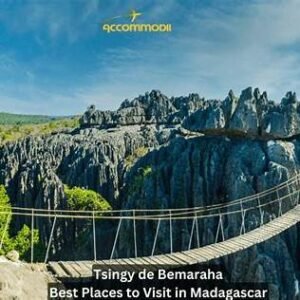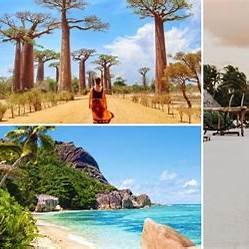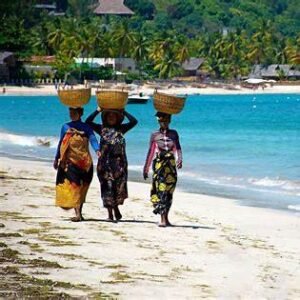



From the moment your plane’s wheels touch down in Antananarivo, you sense that Madagascar is unlike anywhere else on Earth. Ancient island, biological marvel, cultural mosaic—this is a land of extremes and surprises. In 2025, when travelers yearn for originality, few destinations rival the allure of Madagascar. In this article I will take you on a journey through the best places to visit in Madagascar, weaving narrative glimpses of arrival, trek, and revelation, along with practical insights and references for deeper study.
In the first steps, you glimpse bustling markets, narrow streets, and the restless energy of a capital perched in the hills. But soon you leave the city behind. You follow dusty roads, cross rivers by makeshift rafts, and hike through forests where lemurs cry, orchids bloom, and limestone towers rise like petrified flames. You drift across lagoons, snorkel above coral gardens, and meet fishermen whose lives revolve around tide and reef.
This is the Madagascar many dream of visiting. Below I present a curated selection of the best places to visit in Madagascar—destinations that combine natural wonder, cultural depth, and unforgettable adventure. Each section offers narrative texture, factual detail, travel tips, and suggestions for study or further exploration.
Table of Contents
-
Antananarivo and the Central Highlands
-
Andasibe-Mantadia & Analamazaotra: Lemurs, Forests, and Rain
-
Peyrieras Reserve & Reptile Encounters
-
Ranomafana National Park: Tropical Rainforest and Golden Bamboo Lemur
-
Isalo National Park: The Moonscape, Pools, and Canyon Walks
-
Tsingy de Bemaraha & the Grand Tsingy: A Stone Forest of Wonders
-
Avenue of the Baobabs & Morondava
-
Southwest Spiny Forests, Ifaty, and Arboretum d’Antsokay
-
Berenty Reserve & Anosy: Lemurs, Desert, and Culture
-
Andohahela National Park: Meeting Contrasts of the Forest
-
Northern Madagascar: Amber Mountain, Ankarana, and Diego Suarez
-
Nosy Be and Surrounding Islands: Reef, Whale Sharks, and Marine Life
-
Conservation, Challenges & Travel Advice
-
Suggested Itineraries & Further Study
-
Conclusion
Each of these places is one of the best places to visit in Madagascar—and together they map a vision of what a deep, soul-stirring journey might look like in 2025.
1. Antananarivo and the Central Highlands
Your journey to the best places to visit in Madagascar typically begins in Antananarivo, affectionately called “Tana.” As Madagascar’s capital and highland heart, it’s more than a transit hub—it is culture, complexity, and history in one.
Arrival, Markets, and Rova
Descending into Ivato Airport, you are greeted with a palette of red earth, terracotta rooftops, and a sea of green hills beyond. The drive into the city is slow, climbing through switchbacks, past hillside neighborhoods, down into valleys. In the central markets—Analakely, Andravoahangy—you sense the hum of commerce: vibrant textiles, woven hats, fresh produce, zebu meat stalls, and voices calling in Malagasy and French.
High on a ridge above the city sits the Rova of Antananarivo, the former royal palace complex that once housed Kings and Queens of Merina. Though damaged in a 1995 fire, Rova remains an evocative symbol of Madagascar’s central kingdoms. From there, you peer across the red-tiled labyrinth of Tana below, foothills, ridge-lines, and distant hills.
Lemurs’ Park — A Gentle Escape
If you seek a gentle introduction to Madagascar’s wildlife, Lemurs’ Park, about 22 km southwest of the city, is a gem. This 5-hectare reserve shelters nine lemur species roaming semi-freely within botanical gardens. Wikipedia Many of the lemurs were rescued or confiscated pets, now rehabilitated for reintroduction. The reserve also hosts endemic plants and reptiles. A guided visit offers both photography and conservation insight.
Focus and Orientation
Staying two nights in Tana is wise: acclimate, exchange currency, and explore the city’s museums (like the Musée de la Photographie Malagasy) or sample Malagasy cuisine—romazava (meat stew) or ravitoto (crushed cassava leaves). Use this time to confirm arrangements to head east (for rainforests) or west (for dry forests). Many itineraries start from here.
2. Andasibe-Mantadia & Analamazaotra: Lemurs, Forests, and Rain
One of the most beloved stops among the best places to visit in Madagascar is Andasibe-Mantadia National Park (including the Analamazaotra reserve). It lies about 3–4 hours east of Tana and offers your first deep plunge into rainforest magic.
A Night in the Forest
On arrival in Andasibe village, mist clings to trees, and frogs chirp in dim understory light. As evening deepens, you walk by torchlight into the forest edges, guided by a ranger. You might hear the eerie call of the indri—the largest lemur species—echoing from canopy to canopy. You scan trunks for chameleons or nocturnal lemurs like the mouse lemur or the aye-aye (though rare). This “forest at night” walk becomes a rite of initiation for many visitors.
Dawn with Indri and Diademed Sifakas
At first light, you board into the Analamazaotra Reserve (often called “Perinet”) to track the indri. Their mournful calls reverberate through moss-draped trees. You walk narrow paths, guided to family groups. The forest is lush, dripping, alive with orchids and epiphytes, moss, ferns, and bromeliads.
In Mantadia National Park, less visited and wilder, trails lead deeper—through steep valleys, waterfalls, and ridgelines. Here you might glimpse diademed sifakas, black-and-white ruffed lemurs, bamboo lemurs, and many endemic birds. Go2Africa+2ipsmadagascar.org+2
Conservation and Community
Andasibe is not just for tourists. Local guides, reforestation projects, and environmental education centers work in tandem to mitigate forest loss. The Mitsinjo and VOI (ValBio) projects near Andasibe link fragments of forest via corridors, helping species survive. Undiscovered Destinations
If you are a researcher or conservationist, this region offers real case studies: habitat fragmentation, lemur behavior, reforestation models, and the balance of tourism vs ecology.
3. Peyrieras Reserve & Reptile Encounters
As you travel from Tana to Andasibe, about 75 km east along National Road N2, you can make a rewarding stop at Peyrieras Reptile Reserve (also called Madagascar Exotic or Reserve Peyrieras). This privately run facility is a compact showcase of chameleons, frogs, butterflies, snakes, geckos, and small reptiles. Wikipedia
Inside the greenhouses, guides show you panther chameleons flashing turquoise, leaf-tailed geckos clinging like wood grain, and vibrant frogs. Adjacent forest fragments host habituated lemur groups, like Verreaux’s sifaka and red-fronted brown lemur, which visit feeding times. It’s a visitor-friendly way to get close views to reptiles and see Madagascar’s smaller wonders in between big-park visits.
Tip: allocate about 1–2 hours here. It’s a convenient, educational detour en route to Andasibe.
4. Ranomafana National Park: Tropical Rainforest and Golden Bamboo Lemur
Heading south from the central highlands, your next major encounter with biodiversity may be in Ranomafana National Park. Established in 1991, this rainforest is part of Madagascar’s “Wet Tropics” and one of the must-see entries in the best places to visit in Madagascar.
Arrival and Setting
The approach is lined with terraced rice paddies, rolling hills, and mist-shrouded peaks. In the village of Ranomafana, local guides await. At night, the forest hums—cicadas, frogs, tiny insects, and nocturnal mammals stirring.
Trails, Lemurs & Birds
Several hiking circuits thread through mossy gullies, bamboo groves, and ridgelines. You’ll see the golden bamboo lemur, discovered in 1986, which feeds on toxic bamboo shoots that few animals dare touch. Other lemurs include the greater bamboo lemur, black-and-white ruffed lemur, red-bellied lemur, and Milne-Edwards’ sifaka. Undiscovered Destinations+2Helen in Wonderlust+2
Birders may delight in endemic species like the pitta-like ground roller and brown mesite. Orchids and carnivorous pitcher plants hang in damp hollows.
Local Villages & Culture
Ranomafana village offers simple lodging and guesthouses. Meet villagers from Betsileo or Tanala groups, visit honey farms, try local rice and meat stews, and observe how forest-edge agriculture interacts with protected zones.
For further reading, you can explore research on lemur behavioral ecology, rainforest microclimates, and edge effects in protected tropical forests.
5. Isalo National Park: The Moonscape, Pools, and Canyon Walks
From verdant rainforest you move into the drier and more dramatic landscapes of Isalo National Park in the south-central region. Here geology and desert adaptation combine to create one of the best places to visit in Madagascar for contrast and spectacle.
Entering the Canyon
You arrive to red sandstone cliffs, wind-sculpted ridges, deep gorges, and narrow slot-like canyons. Trails lead you through cavernous rock walls, under arches, and past unexpected grassy oases. The light shifts dramatically as dawn or dusk sweeps across the rock faces.
Swimming in Hidden Pools
One of Isalo’s signature experiences is reaching its “natural swimming pools”—cool rock pools fringed by palms and vegetation. After a dusty hike, the sharp relief and sudden green freshness feels like an oasis in the desert. You plunge in, letting the rock walls echo with your laughter.
Sunset on Rock Arches
Climb to a natural window or arch just before sunset. The setting sun floods the canyon rim in burnt orange and golden hues. The rock—eroded by wind and water over millennia—glows like a giant ember. This is the kind of vista that lingers in memory.
Flora, Fauna & Culture
Though dry, Isalo supports unique species, including ring-tailed lemurs and sifakas. The Bara people regard certain caves as sacred, and cave burials remain in rugged cliffs. Your guide may explain the local funerary customs and spiritual significance linked to the terrain.
Isalo is often included in touring circuits as a contrast to rainforest regions. It’s walking-based, moderately strenuous, and rewarding.
6. Tsingy de Bemaraha & the Grand Tsingy: A Stone Forest of Wonders
If you want one of the best places to visit in Madagascar that feels like another world, Tsingy de Bemaraha National Park is a masterpiece of stone. These karst limestone forests—known as tsingy—rise like razor-sharp pinnacles, forming labyrinths, caves, and deep canyons.
The Journey In
The route to Western Madagascar is rugged. You travel from Morondava, cross rivers by pirogue or ferry, and drive over red earth tracks into remote villages. From the village of Bekopaka, trails fan outward. Many tours built around Tsingy include this as a central highlight. Undiscovered Destinations+2Responsible Vacation+2
Petit Tsingy and Grand Tsingy
-
Petit Tsingy is more accessible: wooden walkways, ladders, and narrow corridors lead you deep among stalagmites and forest interior.
-
Grand Tsingy is for the adventurous: steel cables, vertiginous climbs, rope bridges, and sheer drop-offs. The views from the upper ridges deliver a panorama of limestone towers that seem endless.
You discover hidden caves, subterranean rivers, and microhabitats where orchids, ferns, and mosses cling to rock fissures. Wildlife here is elusive but present—lemurs, bats, unusual reptiles, and insect life.
Manambolo Gorge & Canoe Trips
Part of some itineraries includes a canoe trip through the Manambolo Gorge, whose sheer walls rise hundreds of meters above the river. You drift alongside rock faces, hearing calls of birds, and sometimes stopping to explore cave entrances or cliffside trails.
This is one of the most dramatic spectacles of any itinerary and truly earns its place among the best places to visit in Madagascar.
Conservation & Heritage
Tsingy de Bemaraha is a UNESCO World Heritage Site, recognized for its geological, ecological, and cultural values. The local Sakalava communities live in villages nearby and often participate in guiding and hospitality. The challenge is balancing fragile ecosystems with visitor access, and ongoing conservation efforts are essential.
7. Avenue of the Baobabs & Morondava
On the plains west of Tsingy, near Morondava, lies one of the most iconic images of Madagascar—the Avenue of the Baobabs. Here, giant baobab trees line a dusty road, their mighty forms silhouetted against sunrise or sunset.
Dawn & Dusk on the Avenue
You arrive at first light (or stay for dusk). The air is still, the sky soft pastel, and the massive trunks stand sentinel. You walk among them, sometimes alone, photographing from low angles, playing with perspective. At sunset, golden rays make the trees glow, long shadows fan outward, and the horizon darkens in silhouette—magical.
Morondava & Surroundings
Morondava offers lodging, markets, coastal access, and connections to Tsingy routes. From here you can head inland (to Bekopaka and Tsingy), or explore local villages, fishing life, and the transition between forest and savanna.
The Baobabs, though relatively easy to reach, provide one of the most photographed backdrops in Madagascar—making them a staple on any best places to visit in Madagascar roadmap.
8. Southwest Spiny Forests, Ifaty, and Arboretum d’Antsokay
Traveling further southwest, Madagascar’s landscapes shift again. You enter spiny forests—strange, drought-adapted vegetation of thorny shrubs, succulents, and baobabs. Simultaneously, lagoons, coral reefs, and coastal sandbars invite marine exploration.
Ifaty & the Vezo Coast
The coastal village of Ifaty (southwest coast) offers a contrast: beach, reefs, local fishing villages (Vezo people), and coral snorkeling. After inland treks, relaxing on the coastline with sea breeze and marine life is a balm. You may also arrange boat trips for whales or sharks, or nocturnal beach walks. Undiscovered Destinations+2Responsible Vacation+2
Arboretum d’Antsokay
Near Toliara (Tuléar), Arboretum d’Antsokay is a botanical garden set amid spiny forest. It houses roughly 900 plant species, many endemic, and emphasizes conservation of medicinal and threatened flora. Wikipedia Guided tours explain succulent adaptations, local medicinal plants, and botanical conservation. It’s a compact yet powerful window into Madagascar’s dry ecosystems.
These dry ecosystems are an essential complement to rainforest and mountain landscapes, making this region among the best places to visit in Madagascar for ecological variety.
9. Berenty Reserve & Anosy: Lemurs, Desert, and Culture
In the deep south and southeast lies the Berenty Reserve, nestled in the spiny forest along the Mandrare River in Anosy province. For many passionate wildlife watchers, this is a must-see entry among the best places to visit in Madagascar.
Lemurs Up Close
Berenty is one of the most accessible places to see ring-tailed lemurs and Verreaux’s sifaka dancing across rock ledges. Observations here are nearly guaranteed, and guides explain social structure, locomotion, and conservation. Wikipedia
Spiny Forest and Anthropology
The reserve also hosts unique spiny forest plants: octopus trees, Didierea species, and columnar succulents. The nearby Antandroy and Mahafaly culture features wood carving, wooden tombs, ancestor worship, and traditions tied to the land. Guests can experience local dance, meet families, and learn from the ancient relationship between people and environment.
Accommodation & Trails
Berenty has simple lodges within or near forest edge. Trails are gentle, often looped for sunrise or evening walks. It’s a fitting way to close a circuit of Madagascar’s ecosystems: rainforest, canyon, dry forest, desert, coastal, and spiny.
10. Andohahela National Park: Meeting Contrasts of the Forest
On Madagascar’s southeast frontier lies Andohahela National Park, one of the island’s great transitional zones. Recognized as part of the Rainforests of the Atsinanana UNESCO site, Andohahela is remarkable for containing extreme habitat gradients—from humid rainforest to dry spiny zones. Wikipedia
The Three Ecological Zones
-
Malio Zone (wet rainforest): Ranging from about 100 m to 1956 m elevation; dense canopy, ferns, orchids, wild vanilla, and lemurs.
-
Ihazofotsy–Mangatsiaka Zone (dry, spiny forest): Unique reptiles, birds adapted to drier conditions.
-
Tsimelahy Zone (transition forest): Intermixing species from both environments.
Trails may lead you from lush forest through scrub to spiny terrain within one park. This juxtaposition is rare and valuable for both tourism and ecological study.
Access & Advice
Access is by rough roads (e.g. RIP118) from Fort Dauphin (Tolagnaro). Lodging is basic in buffer zones. Because of its remoteness and contrast, the park is better suited to longer itineraries, but for committed travelers it’s a rewarding inclusion among the best places to visit in Madagascar.
11. Northern Madagascar: Amber Mountain, Ankarana, and Diego Suarez
If your itinerary allows a northern leg, be prepared for landscapes unlike any in the south. Northern Madagascar offers rainforest, tsingy, coastal bays, emerald seas, and cultural twists.
Amber Mountain National Park (Montagne d’Ambre)
This is a cool montane rainforest in the far north, with waterfalls, crater lakes, and epiphytic mosses. It’s a biodiversity hotspot with lemurs, chameleons, and orchids, distinct from lowland rainforest. Responsible Vacation
Ankarana Reserve & Tsingy
Near Diego Suarez (Antsiranana), Ankarana Special Reserve features sharp limestone tsingy, underground caves, sinkholes, and suspension bridges. It’s less extreme than Bemaraha but rich in wildlife, nocturnal species, bats, and forest canopies. Go2Africa+3Lonely Planet+3Responsible Vacation+3
Diego Suarez, Ramena, and the Emerald Bay
Diego Suarez (Antsiranana) is a lively port city with French colonial traces. North of it lies Ramena and the “Emerald Sea” – a turquoise bay with calm shallow waters, coral reefs, and beach calm. Boat trips may take you to nearby islets. El País+2blog.cactusmadagascar.com+2
Northern Madagascar is more remote, with less infrastructure, but among those who make the journey, it becomes one of the best places to visit in Madagascar for solitude, contrast, and marine-coastal experiences.
12. Nosy Be and Surrounding Islands: Reef, Whale Sharks, and Marine Life
No account of the best places to visit in Madagascar is complete without mention of the island archipelagos off the northwest coast, especially Nosy Be and its satellite islets.
Nosy Be: Gateway to Island Adventure
Nosy Be is Madagascar’s most popular island resort. It offers beach resorts, diving, marine life, and a tropical atmosphere. From here you can connect to smaller islets. Helen in Wonderlust+2Responsible Vacation+2
Lokobe Reserve & Endemics
One of Nosy Be’s treasures is Lokobe Reserve, a lowland rainforest that shelters Malagasy black lemurs and many endemic reptiles and amphibians. You can embark on guided forest walks, night treks, and canopy observation. Helen in Wonderlust
Marine Experiences: Whale Sharks & Whales
Between September and December, whale sharks frequent the water near Nosy Be, allowing snorkeling interactions (non-invasive). Between August and November, humpback whales may pass in migration, thrilling whale watchers. Helen in Wonderlust
Nearby Islets: Nosy Komba, Nosy Tanikely, Nosy Iranja
-
Nosy Komba (Lemur Island) has small villages, walking trails, and habituated lemurs.
-
Nosy Tanikely is a marine reserve with spectacular reef snorkeling.
-
Nosy Iranja, with twin sandbanks, is a dreamscape of white sand and turquoise sea.
These island visits provide the marine complement to Madagascar’s terrestrial wonders and must be part of any deep itinerary focusing on the best places to visit in Madagascar.
13. Conservation, Challenges & Travel Advice
Endemism and Biodiversity
Madagascar is a global biodiversity hotspot. Approximately 90% of its plant species and 89% of reptiles are endemic. Road Scholar As a result, the island is often called a “living laboratory.” Many species remain under study, and new species are still being discovered.
Threats: Deforestation, Climate & Human Pressures
Madagascar faces serious challenges: slash-and-burn agriculture (tavy), illegal logging, mining, climate change, and habitat fragmentation. Some parks face encroachment and pressure from local subsistence practices. The balance between tourism and preservation is delicate.
In one remote park, Tsingy de Namoroka, as recently as 2025, fewer than 50 visitors had been recorded over several years; yet its ecosystems serve as a final “ark” of life. Financial Times
Best Practices for Travelers
-
Use certified local guides
-
Stay in eco-lodges or locally owned accommodations
-
Avoid disturbing wildlife (no feeding, no loud noise)
-
Keep to marked trails
-
Support reforestation or conservation programs where possible
-
Respect local customs and communities
Logistics, Transport & Timing
-
Internal flights can speed access but are limited and sometimes unreliable
-
Many roads are in poor condition; require 4WD or patience
-
Travel between east and west of the island often routes through central highlands
-
Best seasons: April–November is generally favorable; January–March is cyclone risk
-
Pack for varied biomes: rainforest dampness, dry spiny heat, canyon sun, reef salt
14. Suggested Itineraries & Further Study
Sample Itinerary: Two-week Highlights
Days 1–2: Antananarivo, Lemurs’ Park
Days 3–4: Andasibe-Mantadia (night and day walks)
Days 5–7: Ranomafana rainforest and exploration
Days 8–9: Isalo National Park, pools, canyons
Days 10–11: Travel to Morondava; visit Avenue of the Baobabs
Days 12–13: Tsingy de Bemaraha (Petit & Grand Tsingy, Manambolo Gorge)
Days 14: Return and departure
Add-ons: Berenty, Nosy Be, northern Madagascar.
For Longer Trips & Researchers
-
Extend northwards to Amber Mountain, Ankarana, Diego Suarez
-
Add south-eastern leg to Andohahela
-
Include marine-focused stays in Nosy Be or islands
-
Engage in volunteer or research projects (lemur studies, reforestation, community programs)
-
Read primary literature on Malagasy biodiversity, geology, conservation, and ethnography
Further Reading & Links
-
Travel guides such as Lonely Planet list “10 best places to visit in Madagascar” with up-to-date suggestions Lonely Planet
-
Conservation program websites (e.g. Madagascar Fauna & Flora Group)
-
Journals on tropical ecology, island biogeography, and ethnoecology
Also, if you’re curious, see this internal link to a related travel-style article: The Best Places to Visit in Japan.
15. Conclusion
Madagascar is a land of extremes: towering tsingy forests, jade rainforests, stark spiny deserts, coral seas, and ancestral cultures tethered to land and kin. To travel through the best places to visit in Madagascar is not just to tick off destinations—it is to immerse oneself in evolutionary wonder, cultural resilience, and fragile beauty.


